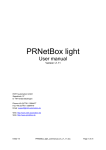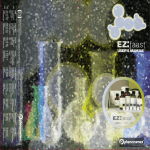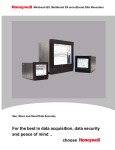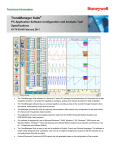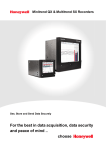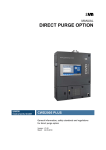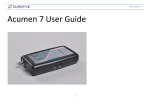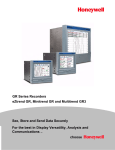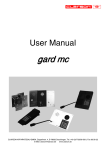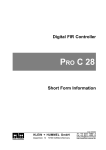Download The data archive - ROTH automation GmbH
Transcript
PRNetBox light User manual Version v1.13 ROTH automation GmbH Zeppelinstr. 27 D- 79713 Bad Säckingen Phone:+49 (0)7761 / 5564477 Fax:+49 (0)7761 / 5564479 Email: [email protected] Web: http://www.roth-automation.de Web: http://www.prnetbox.de 8-Jul-14 PRNetBox_light_usermanual_en_v1_13.doc Page 1 of 30 Table of contents 1 Introduction...................................................................................................................................... 3 1.1 Version..................................................................................................................................... 3 1.2 PRNetBox light......................................................................................................................... 3 1.3 Purpose of this document......................................................................................................... 3 2 Navigation....................................................................................................................................... 4 2.1 Login........................................................................................................................................ 4 2.2 Homepage (Home)................................................................................................................... 5 2.2.1 Content............................................................................................................................. 5 2.2.2 Navigation header............................................................................................................. 5 2.2.3 Username and logout........................................................................................................ 6 2.2.4 Language.......................................................................................................................... 6 2.2.5 Navigation via the menu.................................................................................................... 7 2.2.6 Breadcrumbs navigation line............................................................................................. 7 2.2.7 Footer................................................................................................................................ 7 3 The data archive.............................................................................................................................. 8 3.1 The data archive overview....................................................................................................... 8 3.2 Data archive – display of a data value.....................................................................................9 3.2.1 Selection of the time frame............................................................................................. 10 3.2.2 Selection of the timeframe with the „zoom“mode............................................................11 3.2.3 Selection of the timeframe with the “move“ mode...........................................................11 3.2.4 Automatic update rate..................................................................................................... 12 3.2.5 Statistics of the chosen timeframe..................................................................................12 3.2.6 Visualize the minimum – maximum section (“percentiles” view).....................................13 3.2.7 Magnified view................................................................................................................ 14 4 Actual values................................................................................................................................. 15 5 Alarms........................................................................................................................................... 16 5.1 All errors of the timeframe...................................................................................................... 16 5.2 Actual errors........................................................................................................................... 17 6 Events........................................................................................................................................... 18 6.1 All events in the timeframe..................................................................................................... 18 6.2 Actual events.......................................................................................................................... 19 7 Setpoints....................................................................................................................................... 20 8 Machine values............................................................................................................................. 21 9 I/O values...................................................................................................................................... 22 10 Meter......................................................................................................................................... 23 11 Trends........................................................................................................................................ 24 11.1 Add a new trend................................................................................................................. 24 11.2 Link tags to a trend............................................................................................................. 25 11.3 Lookup trends..................................................................................................................... 26 12 Protocols.................................................................................................................................... 27 12.1 Protocol overview............................................................................................................... 27 12.2 Protocol details................................................................................................................... 28 13 Operating hours counter............................................................................................................ 29 14 Data export................................................................................................................................ 30 14.1 Export configuration............................................................................................................ 30 14.2 Setup configuration............................................................................................................. 30 14.3 Download of export files..................................................................................................... 31 15 Change password...................................................................................................................... 32 16 Glossary..................................................................................................................................... 33 8-Jul-14 PRNetBox_light_usermanual_en_v1_13.doc Page 2 of 30 1 Introduction 1.1 Version This document is dated from the 8-Jul-14 and refers to the version v1.6.13 of the PRNetBox light. 1.2 PRNetBox light The PRNetBox light is a simplified version of the PRNetBox. The biggest difference is that the PRNetBox light is built on a virtual machine which you can download separately at VMware (VMware Player). The PRNetBox is an autonomous industrial PC 1.3 Purpose of this document This document has been made for operators of the PRNetBox light and describes its basic functionalities. It covers the data archive, trending, handling and display of alarms, setpoints, machine values, protocols, operating hours counter, data export, Meters, I/O values, password change and change of events. Admin users, please consolidate the admin manual for details on the administration. The declaration of conformity 21CFR Part 11 is also separately available. 8-Jul-14 PRNetBox_light_usermanual_en_v1_13.doc Page 3 of 30 2 Navigation 2.1 Login Depending on the network configuration of the VMware Player the user interface of the PRNetBox light can have different addresses available. Generally, the user interface can be operated by using standard browsers like Mozilla Firefox, Microsoft Internet Explorer or the Google Chrome browser. To get the best result we suggest using the current Firefox version. You can reach the PRNetBox light as default on the website http://192.168.2.40. In the following figure you see the login screen of the PRNetBox light. As operator you will be asked to enter a user name and password. You can change the languages in the upper right corner by clicking on the flags. Figure1: Login Note: If the password has been entered three or more times wrong the operator login will be locked for a timeframe of 30 minutes. This rule does also apply for the administrator. After the first login to the system the password needs to be changed. The administrator sets the aging of the password and he chooses if the password can be reused. The administrator sets after how much time of inactivity the operator will automatically be logged out from the system. Every attempt will be logged in the audit trail of the system and cannot be removed or changed. 8-Jul-14 PRNetBox_light_usermanual_en_v1_13.doc Page 4 of 30 2.2 Homepage (Home) After a successful login at the system, the user with the privileges of an operator is going to see this homepage and menu: Figure 2: Homepage (Home) 2.2.1 Content On the homepage you see the recent health status of the system. You get an overview how much disk space you still have and how long this capacity will last without deleting any old data archives. Errors with the mentioned modules would be displayed here, too. Therefore you can consolidate the error log. Please contact your administrator in this case. 2.2.2 Navigation header On the very top of the webpage you can find the navigation header with some important features. Figure 3: Navigation header 8-Jul-14 PRNetBox_light_usermanual_en_v1_13.doc Page 5 of 30 2.2.3 Username and logout On the left side you see the name of the current user. Next to it is the logout link where you can logout in case you are not at the machine to prevent any abuse. 2.2.4 Language The language can be selected by clicking on one of the flag icons on the top of the page. The selected language will be active through the whole session. The selection will be saved when logging out. With the next login the language will be the same as in the moment the user has been logged out. You can choose out of the following languages: German English French Spanish Portuguese Italian Dutch Polnisch Norwegian Czech Russian Chinese Swedish Serbian English and German are provided in each version. Because of the continuous improvement of this system some texts are not translated into every language. If this is the case, the text will be shown in English. Also in the navigation header you find the search field where you can enter the name of a data value, comment or description. Figure 4: Searching for „temp“ You get a list of results. In the case shown below it has been searched for „temp“. Now you can click on the name of the data value in the result list and that brings you automatically to this data value in the data archive. 8-Jul-14 PRNetBox_light_usermanual_en_v1_13.doc Page 6 of 30 2.2.5 Navigation via the menu The menu is on the left side of the webpage. Via the links listed you get to the specific themes. By clicking on the “+” or “-“ you can open and close the submenu. Figure 5: Main menu 2.2.6 Breadcrumbs navigation line By clicking on the fields in the breadcrumbs navigation line you can get to the specific themes, too (You are here …) and you can see were you are, respectively, how you get there. This is useful in cases you are already in the 4th or 5th level. 2.2.7 Footer In the footer you find a link to the start page „home“ , a logout button and an arrow to get back to the top of the page. Figure 6: Footer 8-Jul-14 PRNetBox_light_usermanual_en_v1_13.doc Page 7 of 30 3 The data archive Here you find all data values (tags) which have been setup by your administrator. For further information about how new data values will be collected automatically by the system, please refer to the admin manual. 3.1 The data archive overview Go to “Main menu” -> “data archives“ to get the list of all tags and values (see also figure). Here you can see the name of the tag, its recent value in the PLC, its data type, its address in the PLC and a description of the tag. Figure 7: Data archive- overview In the first column of the table you find a drop down menu. You can choose between different filters. You can filter the values by “setpoints”, “machine data”, “actual values”, “alarms”, “input/output” or “events”. Also you can filter in the next drop down menu by data type. These two filters can also be combined. For example you could filter to see only “setpoints” with the type “Integer”. In the search field you can search a tag by name or data block. In the drop down menu of the field “results per page” you can select your view of results. 8-Jul-14 PRNetBox_light_usermanual_en_v1_13.doc Page 8 of 30 3.2 Data archive – display of a data value By clicking on the name of the data value you get to the detailed view where you can see all values as a trend. You can choose between minimum, maximum, average and actual values (see figure). Figure 8: Details for a temperature data value To every data value which has been configured, the archived data values can be shown. “Integer”, “Real”, “Byte” and “Boolean” values are displayed as trend in addition. Data values with the data type “String” are written as text. The possibilities of this feature are explained in the next chapters. 8-Jul-14 PRNetBox_light_usermanual_en_v1_13.doc Page 9 of 30 3.2.1 Selection of the time frame The observation time frame can be chosen by clicking on the different buttons. You have the following possibilities: The last 10 minutes The last hour The last 24 hours One day One week One month Last year This year Choose time frame manually If you choose to choose the time frame manually, you can enter a start data and an end date in the calendar. You only have to click on the date to see the calendar. You also have the option to define the timeframe down to seconds as you can see in the next figure. Figure 9 : Choose the date out of the calendar Once the timeframe has been chosen, this time frame stays active also for the pages alarms, events, protocols and trends to prevent you from reentering the data allover again. The shorter the timeframe is chosen the more precise is the display of the trend. Following basic display settings are available and will be used automatically depending on the selected time frame. The following table can only be used as reference how the data will be read. This can be different depending on the quantity of data in the chosen timeframe. Just on top of the trend you can see which view is recently used. 8-Jul-14 PRNetBox_light_usermanual_en_v1_13.doc Page 10 of 30 Timeframe 0 seconds – 60 seconds 61 seconds – 60 minutes 1 hour – 24 hours 1 day – 7 days 1 week – 1 month Longer than 1 month View All available and recorded values in milliseconds. Average per second Average per minute Average of 10 minutes Average of 1 hour Average of a day 3.2.2 Selection of the timeframe with the „zoom“mode Alternatively you can choose the timeframe also within the trend. Please note that you first have to make sure that you´ve select the „Zoom“ mode. In the figure you can see the button on the top of the trend on the left side. Figure 10: Select timeframe manually First you choose a larger timeframe than you need and then you select the timeframe in the trend while holding the left mouse button. As soon as you loosen the mouse button the trend will be refreshed into the chosen selection. On the top right side of the trend you can see the current date and the current value referring to the cursor position. Alternatively you can select the timeframe in the overview on the bottom of the trend. Here you can only choose the timeframe not the scale. 3.2.3 Selection of the timeframe with the “move“ mode As soon as you have clicked on the button “zoom” mode the “move“ mode function is going to be enabled. That means that you can swipe the trend left and right as you can on recent smart phones. You just have to click on the left button of your mouse and move it left or right. 8-Jul-14 PRNetBox_light_usermanual_en_v1_13.doc Page 11 of 30 3.2.4 Automatic update rate You can choose the option to automatically refresh your data in a defined rate if you choose one of the following timeframes: The last 10 minutes The last hour On top of the trend you can check a box with the description “enable monitoring view“. It is not possible to zoom in the “monitoring view” If you would like to zoom into a timeframe, you can zoom before you choose this option. If you check this box, you can choose how quick the PRNetBox will run an automatic update. The rates you can choose are 1, 2, 5 or 10 seconds. If you go into the diagram with the mouse cursor, the value of its position will be shown. Depending on the update rate, the value will be overwritten as soon as the new value appears. Figure 11: Monitoring view 3.2.5 Statistics of the chosen timeframe The minimum, maximum, actual, and averages of the values that have been recorded in a timeframe are displayed in text form. Additionally these values can be displayed in the trend according to the selection you´ve made (see figure) 8-Jul-14 Figure 12: Different options to display the values in the statistic PRNetBox_light_usermanual_en_v1_13.doc Page 12 of 30 3.2.6 Visualize the minimum – maximum section (“percentiles” view) If you set the check the box “enable percentiles view“ you can see in which section the data has been recorded in a large timeframe (between the minimum and maximum values). In the following figure you see a timeframe of +/- 8 days in the activated “percentiles” view. The red curve displays the average value of the data. The shadow shows where the data has been recorded. Figure 13: Percentiles view activated If you zoom in to approx. one day, the data will be refreshed automatically and displayed as shown below. Figure 14: Zoom on day basis 3.2.7 Magnified view With a click on the magnifier you can enlarge the trend display for optimization of the print layout with the printer function of the web browser. 8-Jul-14 PRNetBox_light_usermanual_en_v1_13.doc Page 13 of 30 4 Actual values Go to “Main menu” -> “Actual values” to see all current values for the actual value tags. In the overview you will see the name of the tag, the value, the unit and the description of the tag. Figure 15: Actual values overview The exceptionality of this page is, that the values are refreshing constantly automatically. So you do not have to press any refresh button to see the most current value of the tag! The administrator defines which actual values will be displayed in this view. He can also decide which layout will be used for which actual value. 8-Jul-14 PRNetBox_light_usermanual_en_v1_13.doc Page 14 of 30 5 Alarms Go to “Main menu” -> “Alarms” to get to the page where all the defined alarms are listed. 5.1 All errors of the timeframe Similar to the data archive you can choose here a time frame of interest. Like this you can track the emerged alarms. On the bottom of the page the alarms will be listed. At the moment the alarm raises the time will be logged and a red arrow will appear in front of the listed tag. As soon as the alarm goes, the time will be logged again and a green arrow will appear in front of the listed tag. Click on the red buttons for timeframe selection or enter a relevant date and time manually. Figure 16: All errors of the timeframe You have the following display options: Results per page Refresh rate: 5,10,30,60 seconds (0= no refresh) Search: by tag name Sort table: By clicking on the arrows in the table you can sort the content of the column decreasing or descending Link to diagram: Click on the red shaded text to go directly to the diagram of the tag Note: Maximum 250 changes will be listed. You will get a message if you selected a time frame with more than 250 alarm messages. 5.2 Actual errors If you only want to see all current alarms, select „Actual errors“ as display type. 8-Jul-14 PRNetBox_light_usermanual_en_v1_13.doc Page 15 of 30 6 Events Go to “Main menu” -> “Events“ to get to the page where all events are listed. Events are defined by a rising or a falling edge of a bit. The administrator can define which bit should raise the event. Also he can define whether it should be raised with the rising or the falling edge of the bit. The log of the parameter can be defined separately for the rising or the falling edge. To one event an almost unlimited number of parameters can be defined. For example a motor start or the start of a function could be defined as an event. Sometimes it makes sense to define an alarm as event and to add a parameter. For example if you would have an alarm defined for “temperature too high” it would make sense to log the temperature as parameter. Like this you see when the temperature went to high and what the value was. 6.1 All events in the timeframe If you select this option you´ll see all events that have been logged in a specific time frame. Green “ON“ icons illustrate the rising edge of the event. Red “OFF” icons illustrates the falling edge of the event. Figure 17: All events of the timeframe You have the following display options: Results per page Refresh rate: 5,10,30,60 seconds (0= no refresh) Search: by tag name Sort table: By clicking on the arrows in the table you can sort the content of the column decreasing or descending Note: Maximum 250 changes will be listed. You will get a message if you selected a time frame with more than 250 alarm messages. 6.2 Actual events If you select “Actual events“ as display type, only the current event will be listed. 8-Jul-14 PRNetBox_light_usermanual_en_v1_13.doc Page 16 of 30 7 Setpoints Go to “Main menu” -> “Setpoints” to get to the page for setpoints where you get an overview of all changed setpoints in a time frame of your choice. Any tag (data value) can be set as a setpoint by the administrator. A setpoint is a tag which has a standard value in a specific function but can be changed sometimes to get different results in production. P.ex. the rotation of the motor. Figure 18: Changes in setpoints You have the following display options: Results per page Refresh rate: 5,10,30,60 seconds (0= no refresh) Search: by tag name Sort table: By clicking on the arrows in the table you can sort the content of the column decreasing or descending Link to diagram: Click on the red shaded text to go directly to the diagram of the tag Note: Maximum 250 changes will be listed. You will get a message if you selected a time frame with more than 250 alarm messages. 8-Jul-14 PRNetBox_light_usermanual_en_v1_13.doc Page 17 of 30 8 Machine values Go to “Main menu” -> “Machine values” you get an overview about all changed machine values in a specific time frame of your choice. Any tag (data value) can be set as a machine value by the administrator. A machine value is a tag which is a specific system setting which should normally only set once in the startup procedure of the machine. Figure 19: Changes in machine values You have the following display options: Results per page Refresh rate: 5,10,30,60 seconds (0= no refresh) Search: by tag name Sort table: By clicking on the arrows in the table you can sort the content of the column decreasing or descending Link to diagram: Click on the red shaded text to go directly to the diagram of the tag Note: Maximum 250 changes will be listed. You will get a message if you selected a time frame with more than 250 alarm messages. 8-Jul-14 PRNetBox_light_usermanual_en_v1_13.doc Page 18 of 30 9 I/O values Go to “Main menu” -> “I/O values” to get an overview about all changed I/O values in a specific time frame of your choice. Any tag (data value) can be set as an I/O value by the administrator. I/O values are used for observation of inputs and outputs of the PLC. Figure 20: I/O values You have the following display options: Results per page Refresh rate: 5,10,30,60 seconds (0= no refresh) Search: by tag name Sort table: By clicking on the arrows in the table you can sort the content of the column decreasing or descending Link to diagram: Click on the red shaded text to go directly to the diagram of the tag Note: Maximum 250 changes will be listed. You will get a message if you selected a time frame with more than 250 alarm messages. 8-Jul-14 PRNetBox_light_usermanual_en_v1_13.doc Page 19 of 30 10 Meter Go to “Main menu” -> “ Meter” where you can see the configured meters in certain time ranges. Any data can be added to the meters and any meters can be configured. Therefore you need admin rights. Please also look up the admin user guide. Figure 21: Data list meter On this page you can lookup easily important data and the differences of values. Therefore choose the range in the drop down menu and click on refresh. To lookup the data on the screen click on “Load data”. You can also choose to download the data as CSV file. 8-Jul-14 PRNetBox_light_usermanual_en_v1_13.doc Page 20 of 30 11 Trends 11.1 Add a new trend Go to “Main menu” -> “Trends“ to get to the page where you can add and edit trends. You can now choose a name for your trend. This name will be used in the listings. If you choose a name which already exist you´ll get a warning. The entry of a name is obligatory. Figure 22: How to add a trend If you check the box “Share trend” every user can see your trend configuration. If not, only you will have access to the trend. Also you can add a comment to explain the trend further. To save the new trend, hit “Create”. Now that the trend has been added you´ll get a table below the entry fields. Here you see the name, the comment and also whether the trend is shared or not. Figure 23: The first trend This new trend does not have any data values linked to it. To add data tags to the trend, click on the edit icon on the left side of the trend name. This is explained in the next chapter in more detail. To delete the trend click on the delete icon left to the name of the trend. You will be asked if you really want to delete the trend. To display the trend, just click on the trend name. If no data tags are linked yet you can´t click on the name, because the trend is still inactive. 8-Jul-14 PRNetBox_light_usermanual_en_v1_13.doc Page 21 of 30 11.2 Link tags to a trend After clicking on the „edit”-icon left to the name of a trend configuration an input form to add new tags will be shown. Figure 24: Link tags to a trend In the drop down ”New value” menu you get a list of all configured tags in the system (except data values of data type „String“). If you click in the color field you get a big range of available colors to choose the color for the data of the tag in the trend. Figure 25: Choose a color for the curve of the tag in the trend For every trend configuration you can add up to 20 tags. The field “multitrend group“ allows to add several tags in one group so you can see them in one trend. You can choose any number in this field. Each tag of “multitrend group” 0 is shown in a single chart. The fields “Y-Scala Minimum“ and “Y-Scala Maximum“ set the Y-Scale minimum and maximum values. For automatic scale range determination enter “0” in both fields. Through clicking on the button “Add value to trend“ the trend will be modified and you can access your new trend. The trend you´ve added will be shown in the list below the mask for the configuration of a trend. 8-Jul-14 PRNetBox_light_usermanual_en_v1_13.doc Page 22 of 30 Figure 26: Trend configuration A tag can be removed from the trend configuration by clicking on the “delete” icon in front of the tag name. A tag configuration can be changed or modified by clicking on the “edit” icon accordingly. 11.3 Lookup trends Through clicking on the configured trend name you get to the display of the trend with all configured tags, their colors, scales and values. In the example shown in the figure three data tags have been assigned to the same multitrend group, though they are shown in one trend. The timeframe shown can be chosen by changing the “Range” selection or using the zoom functionality of the trend. 8-Jul-14 PRNetBox_light_usermanual_en_v1_13.doc Page 23 of 30 12 Protocols Go to “Main menu” -> “Protocols” where the list of all protocols is shown. Protocols can be issued for different purposes. The main purpose is to make a protocol for an automatic run, for example a recipe of a product or a batch. The PRNetBox can save an almost unlimited quantity of protocols and several protocols can be saved simultaneously. The information that is going to be recorded in the protocol is defined by the administrator. Following details are in disposal for configuration: Alarms Events Changes in setpoints Changes in machine values All values the system records can be shown in the header of the protocol o A certain value at the beginning of the protocol o At the end of the protocol o The difference between begin and end in case of numeric values All kinds of trends for all data values recorded in the system. You can choose to add several data values in one trend or configure different data values in separate trends Meter readings in defined time intervals. Also the difference to the last value can be calculated Since you have the option to issue several different configured protocols simultaneously you have the possibility to get protocols with different details. 12.1 Protocol overview As you can see in this figure you see on the link for protocols the overview over all recorded protocols. This overview shows all protocols of a certain timeframe. The start of the protocol counts for selection. Figure 27: protocol overview In the overview the following information is listed: the batch number, the batch name, the date and time the protocol started and ended. The quantity of events and the quantity of alarms are also shown in the overview. Through the link of the protocol name, e.g. „mid night” you can see the details of the protocol. By clicking on the pdf icon you can download the protocol as pdf file, save or print it. All protocols are saved on a network share on the PRNetBox. You can access this drive via the IP address or via the configured name in the system. This share is not password protected. The network share is write- protected, nothing can be changed. The network drive suits perfectly for automated backup of all protocols by a company own data server. 8-Jul-14 PRNetBox_light_usermanual_en_v1_13.doc Page 24 of 30 12.2 Protocol details If you click on the red shaded protocol name you get to see all details of your protocol. It contains the same data as if you download your protocol as pdf document. But here you can select in the drop down menu “Show” which information you would like to see (setpoints, events, alarms, actual values). In case of large protocols with many header information, this can be useful. Figure 28: details of a protocol 8-Jul-14 PRNetBox_light_usermanual_en_v1_13.doc Page 25 of 30 13 Operating hours counter Go to “System” -> “Operating hours” to see the configured meters. The operating hours counter help to determine when the next service needs to be done for specific elements. The table shows the tag name, the description, the sum of hours, the set limit and the total of the operating hours. A green check mark illustrates that the limit which has been set by the administrator has not been reached yet. A red exclamation mark means that the limit has been exceeded. After that the service has been done, the administrator sets the count of hours (sum hours) back to zero (see admin user manual). Figure 29: Operating hours counter overview 8-Jul-14 PRNetBox_light_usermanual_en_v1_13.doc Page 26 of 30 14 Data export Go to “System” -> “Data export“ to download data of a certain period. 14.1 Export configuration In the drop down menu “Range“, you choose which timeframe you would like to look up. For example: The 4th december 2012 until the 5th of december 2012) The drop down menu “Timeframe“ sets the data density (e.g. second- or hour- or day averages) The drop down menu “Configuration“ gives you the possibility to choose which tags you would like to export. As default you can only choose “Export all tags“. But it is possible to setup configurations which consist user defined „tags“. Those customized definitions would then be available in the drop down menu (see next chapter) In the section “Others“ you can choose to export “Setpoints”, “Machine values” or “Actual value” tags by checking the specific box. Click on “Start data export” to run the export. Figure 30: Data export configuration 14.2 Setup configuration The configuration setup can be found below the export data fields. With configurations you can export specific tags. A name has to be specified in order to create a new data export configuration. Click on “Create configuration“. Figure 31: Setup a new configuration for export The new configuration appears below the entry fields. 8-Jul-14 PRNetBox_light_usermanual_en_v1_13.doc Page 27 of 30 Figure 32: Edit new configuration If you click on the “edit“ icon you can add the tags you wish to add. You can add several tags to the configuration. Figure 33: Add tag to create a new value to the configuration 14.3 Download of export files Once the data export has been started, the export task is shown on the bottom of the page . Figure 34: Export is running As soon as the export has been finished, you can download the data. You can see that in the last three columns. The data is provided in „csv-format“. 8-Jul-14 PRNetBox_light_usermanual_en_v1_13.doc Page 28 of 30 15 Change password Go to “System” -> “Change password” to get to your password configuration. It is mandatory to change your password on regular basis to prevent the access of others. Therefore you can click in the menu on “change password”. As you can see in the following figure you have to enter your old password to be able to define a new password. In case your password has expired or the system time has been changed, you have to enter a new password. Or sometimes the login gets blocked. Please contact your administrator in case of difficulties. Figure 35: Change password The new password is activated by clicking on “Save new password“. 8-Jul-14 PRNetBox_light_usermanual_en_v1_13.doc Page 29 of 30 16 Glossary Tag PRNetBox IPC 8-Jul-14 A data value in the plc control which has an address assigned, like DB1.DBX0.1. Protocol and recipe management with a PC Box (IPC) which has been plugged into the network Industrial PC PRNetBox_light_usermanual_en_v1_13.doc Page 30 of 30






























